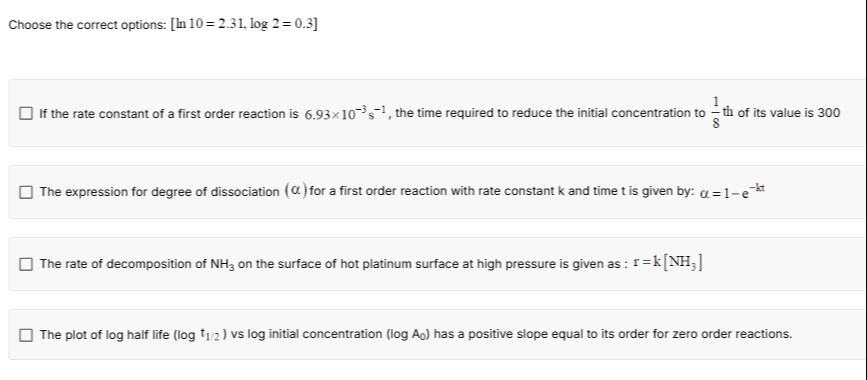Question
Question: Choose the correct options: [ln 10 = 2.31, log 2 = 0.3]...
Choose the correct options: [ln 10 = 2.31, log 2 = 0.3]

If the rate constant of a first order reaction is 6.93×10⁻³s⁻¹, the time required to reduce the initial concentration to 81th of its value is 300
The expression for degree of dissociation (α) for a first order reaction with rate constant k and time t is given by: α = 1-e⁻ᵏᵗ
The rate of decomposition of NH₃ on the surface of hot platinum surface at high pressure is given as: r = k[NH₃]
The plot of log half life (log t₁/₂) vs log initial concentration (log A₀) has a positive slope equal to its order for zero order reactions.
Option 1 and Option 2
Solution
The question asks to choose the correct options from the given statements related to chemical kinetics. We will analyze each statement individually.
Statement 1: If the rate constant of a first order reaction is 6.93×10⁻³s⁻¹, the time required to reduce the initial concentration to 81th of its value is 300 s.
For a first-order reaction, the integrated rate law is given by: t=k2.303log[A][A]0
Given: Rate constant, k=6.93×10−3 s−1 Initial concentration, [A]0 Final concentration, [A]=81[A]0 So, [A][A]0=8
Substitute the values into the equation: t=6.93×10−32.303log8
We know that log8=log(23)=3log2. Given log2=0.3. So, log8=3×0.3=0.9.
t=6.93×10−32.303×0.9 t=6.93×10−32.0727 t≈299.09 s≈300 s
Alternatively, we can use the half-life concept. For a first-order reaction, the half-life (t1/2) is given by: t1/2=kln2=k0.693 Given k=6.93×10−3 s−1: t1/2=6.93×10−30.693=0.006930.693=100 s
To reduce the concentration to 81th of its initial value means the reaction has undergone three half-lives: [A]0t1/221[A]0t1/241[A]0t1/281[A]0 Total time t=3×t1/2=3×100 s=300 s. Thus, the statement is correct.
Statement 2: The expression for degree of dissociation (α) for a first order reaction with rate constant k and time t is given by: α = 1-e⁻ᵏᵗ.
The degree of dissociation (α) is the fraction of the reactant that has reacted. If [A]0 is the initial concentration and [A] is the concentration at time t, then the amount reacted is [A]0−[A]. α=[A]0[A]0−[A]=1−[A]0[A]
For a first-order reaction, the integrated rate law is: ln[A]−ln[A]0=−kt ln([A]0[A])=−kt Taking the exponential of both sides: [A]0[A]=e−kt
Substitute this expression into the equation for α: α=1−e−kt Thus, the statement is correct.
Statement 3: The rate of decomposition of NH₃ on the surface of hot platinum surface at high pressure is given as: r = k[NH₃].
The decomposition of ammonia (NH₃) on a hot platinum surface is a heterogeneous catalytic reaction. At high pressure, the surface of the catalyst becomes saturated with ammonia molecules. This means that all the active sites on the catalyst surface are occupied. Therefore, increasing the concentration of NH₃ further does not increase the rate of reaction as there are no more vacant sites for the molecules to adsorb and react. In this scenario, the reaction becomes independent of the concentration of NH₃, i.e., it becomes a zero-order reaction. So, at high pressure, the rate is r=k. The given expression r=k[NH3] implies a first-order reaction, which is true at low pressures, but not at high pressures. Thus, the statement is incorrect.
Statement 4: The plot of log half life (log t₁/₂) vs log initial concentration (log A₀) has a positive slope equal to its order for zero order reactions.
For a zero-order reaction, the integrated rate law is: [A]=[A]0−kt At half-life (t1/2), [A]=2[A]0. 2[A]0=[A]0−kt1/2 kt1/2=[A]0−2[A]0 kt1/2=2[A]0 t1/2=2k[A]0
Now, take the logarithm of both sides: logt1/2=log(2k[A]0) logt1/2=log[A]0−log(2k)
This equation is in the form of a straight line y=mx+c, where y=logt1/2 and x=log[A]0. The slope m=1. The intercept c=−log(2k).
For a zero-order reaction, the order is 0. The plot of logt1/2 vs log[A]0 has a positive slope equal to 1. The statement says the slope is "equal to its order", which would imply a slope of 0. Since the calculated slope is 1, and not 0, the statement is incorrect. (The slope is generally 1−n where n is the order of reaction). Thus, the statement is incorrect.
Conclusion: Based on the analysis, statements 1 and 2 are correct.
